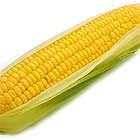The justification of course is that Japan needs to recover from the 3/11 earthquake and tsunami. 日本復興(Nihon Fukkou) The country`s economy has been devastated by the cost of the 3/11 disaster and politicians are scrambling to try and pull money to pay for the restoration of East Japan. However, by allowing such toxic levels of radiation to be spread around the country, dire consequences will most certainly manifest in the future.
 |
| This market down the street is selling cucumber from Fukushima. Following the policy of the government to support and buy produce from East Japan in order to restore the economy |
When people eat food that is emitting radiation that more than likely means there are radioactive isotopes present. These particles are absorbed by the body and will surely cause health problems even cancers. Young children eat and drink this tainted food without a thought. They are even forced to eat it at schools, and many experts fear that once the amount of internal radiation in their bodies reaches a certain level or when they go through a growth spurt many health problems will develop.
Here is an example of how sneaky companies are getting when selling potentially harmful food and drink. This is happening because of the vast amount of surplus in radioactive areas being sold so cheap and again these practices support Fukkou policy. This drink is labeled Fukushima on the front which is a dead give away that you shouldn`t buy it but as I look at the back, the company that packaged and sold it is located in Hokkaido and the company that processed the juice is located in Ibaraki. If you are not careful ,and sometimes it is hard to determine, you can ended buying juice that was sold from Hokkaido (safe) but made in Fukushima (not safe)
This information about food contamination and internal exposure to radiation is mostly dismissed by the mainstream media and television. Yet some grocers and restaurants see this as a business opportunity |
| A family restaurant, Bamiyan posts on the door that all beef is American and has been strictly tested. |
Food delivery companies who deliver food from the south and more western areas of Japan are becoming a popular alternative for buying food. Also some companies will check each piece of food you buy from them via Geiger counter. These companies charge about $5 for an ear of corn or $2 for a tomato.
Oshix has become a very popular way to get safe food but most people like me couldnt afford it.But what happens after a year or more. The food supply for the whole country cannot be supported by half of Japan`s farming land. Also there are grave concerns about fertilizer from affected areas being sold all over the country risking the contamination of rice fields all around Japan. Currently Japan is consuming the rice crop from last year but what happens when it is gone and the rice crop is gathered and sold to the people. Then there will be no way around it. Food will be radioactive, leading to more risks of internal exposure to the entire nation not just East Japan.
Estimates of some experts like professor Kodama of Tokyo University gauge that even by this fall children may begin to exhibit symptoms of radiation poisoning. (basically the body cannot handle anymore so it begins to break down).
These symptoms include sore throat, metallic taste, headache, nausea, vomiting, nosebleeds, diarrhea, and in some cases can be fatal.
Japan is facing 2012 thinking about its economy and trying to revive Japan, but it could be facing an epidemic if measures are not taken to protect and preserve the food supply.




No comments:
Post a Comment